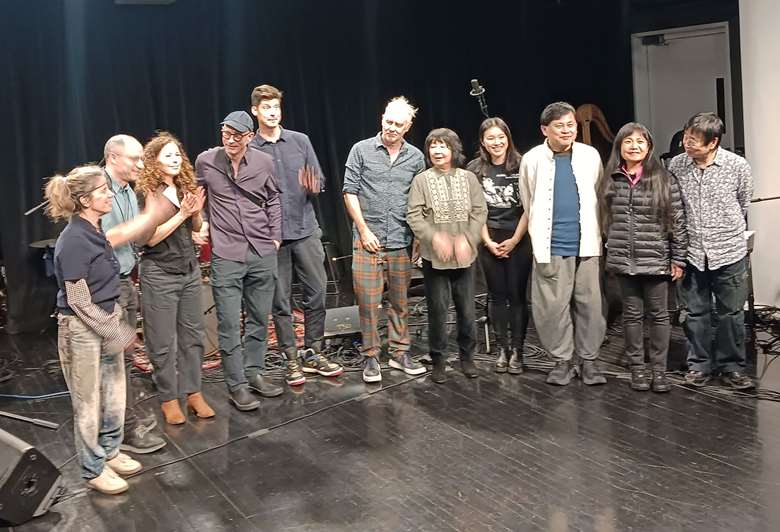Ikue Mori hits 70 with Ches Smith, Satoko Fujii and more at The Stone, NYC
Andrey Henkin
Tuesday, December 19, 2023
The avant electronica artist gathers a vast array of cutting edge jazz and improvising musical talent to mark her seventh decade

Maybe to celebrate a birthday a lawyer and her pals get together to file rafts of motions or some doctor gathers all his specialist friends for a major surgical procedure, but it is pretty much assured that a musician will play a gig on that special day.
So it was that electronicist Ikue Mori closed out her mid-December curatorship at The Stone at The New School with a 70th birthday concert, inviting back many of the participants from the week’s earlier concerts. It took place on the day itself, Sunday, 17 December, held in the college’s fourth floor theater, and ended with 70+ cupcakes presented to the birthday girl and devoured by the audience.
The late afternoon concert, titled ‘Sun Tracing Magic’, was split into two sections with different ensembles, Mori and drummer Ches Smith the only players participating in both (though the latter was a sub in the first set for an ailing Sae Hashimoto). The first had the pair with pianist Satoko Fujii, trumpeter Natsuki Tamura, harpist Zeena Parkins, cellist Erik Friedlander and vocalist/cornetist/theremin player Koichi Makagami. The second was completed by reedplayer Ned Rothenberg (moving among shakuhachi, alto saxophone, clarinet and bass clarinet), pianist Sylvie Courvoisier, vocalist/electronicist Charmaine Lee and bagpiper David Watson.
This was just over an hour of programmatic music, two segments per set, each comprising two pieces, each at 15-minutes duration apart from the final 22-minute one. All were dedications – to painters Agnes Martin, Judit Reigl, Leonora Carrington and Toko Shinoda, performance artist Joan Jonas (twice), sculptor Louise Bourgeois and Buddhist nun Jakucho Setouchi – and followed scores and various cues. Mori, who in other contexts has her electronics tend towards glitchy binary-esque gestures and extraterrestrial washes, created very specific, highly melodic and extremely evocative paragraphs of sound over and under and through which the other players dialogued.
The first group was notable for its emphasis on strings, whether they were plucked, bowed, hammered or, at several points, flossed inside the piano by Fujii. During the second piece, Tamura and Makagami jousted with each other on trumpet/cornet across the stage. With Parkins also processing her harp, it was often difficult to pinpoint who was generating what sound, making for an enjoyably confusing listen. This group worked as an ensemble, volume and density swells taking on the personality of radioactive bursts or exultant congregation. Makigami tended to keep his vocalising in the lower register, with appealing feral grunts and groans, his theremin adding yet another texture to one of the most unique sounding bands this reviewer has heard.
The second band functioned very differently, concentrating more on sub-groupings, thus allowing for easier audio identification, and Smith, who had been in the role of colorist in the first set, much more rhythmically active. After an introduction by Lee using both vocal and contact mics (the latter secured to her throat with surgical gauze) to process her voice – in contrast to Makigami, she was more shrill and strangled – Shinto-temple-like strains were juxtaposed against shakuhachi before a section with clarinet, piano, alto and jittery percussion. Later circular-breathed bass clarinet floated like dark matter through cosmic electronic signals, bagpipes entering to add a further drone element. What had been a moody dream was exploded by a cued alto/piano/drums portion, bagpipes reentering and then left alone to asphyxiate slowly into silence. The second piece felt animated, as in a soundtrack to a disjointed cartoon, particularly during a manic chase from alto and piano, before morphing into a lugubrious ballad from the full ensemble, the music closing with various solos until the sextet closed as one.
It was a testament to Mori’s deliberate intentions and maturity of seven decades that the two ensembles were NOT joined together for a meandering Rock & Roll Hall of Fame-like jam after all that.